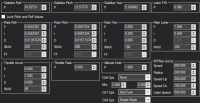crayfellow
Member
I have not had much luck using autotune (APM / Pixhawk) on heavy lifters but that has a lot more to do with my extremely limited time. Generally, when the conditions are right I have a short time for some quick adjustments or a test and I have to go onto the next thing.
Thanks to @Mactadpole I have some great starting params that fly great on one class of craft. I ended up using pretty much the same values on a craft that will be used for some scientific imaging work. The frame is the rock solid, super stable HexaCrafter HX-1000 running U7-420kv spinning 18" T-motor CF blades.
For the most part it flies great, but at hover it's got a definite, persistent oscillation in Loiter which suggests a high "P". The oscillation appears to be "2 dimensional" along both pitch and roll axes, which of course makes sense.
Can you guys check the params and recommend how much of a tweak I should make without losing pitch/roll response and crashing this work of art? I am guessing I should lower the "Rate Roll" and "Rate Pitch" P values, but I am also guessing I'd need to lower the I's as well - and when I do, should I lower those super high Stabilize Roll and Stabilize Pitch P values?
View attachment 27037
There is so little info out there on tuning heavy lifters, I am highly motivated to make some sort of tune sharing online resource of some sort. It was a huge help to have a jumpstart of some working values on a similar craft. But I am thinking even just having something to eyeball when running autotune would be great for a lot of fliers.
@jdennings or @R_Lefebvre any chance you guys can weigh in?
Cheers!
Thanks to @Mactadpole I have some great starting params that fly great on one class of craft. I ended up using pretty much the same values on a craft that will be used for some scientific imaging work. The frame is the rock solid, super stable HexaCrafter HX-1000 running U7-420kv spinning 18" T-motor CF blades.
For the most part it flies great, but at hover it's got a definite, persistent oscillation in Loiter which suggests a high "P". The oscillation appears to be "2 dimensional" along both pitch and roll axes, which of course makes sense.
Can you guys check the params and recommend how much of a tweak I should make without losing pitch/roll response and crashing this work of art? I am guessing I should lower the "Rate Roll" and "Rate Pitch" P values, but I am also guessing I'd need to lower the I's as well - and when I do, should I lower those super high Stabilize Roll and Stabilize Pitch P values?
View attachment 27037
There is so little info out there on tuning heavy lifters, I am highly motivated to make some sort of tune sharing online resource of some sort. It was a huge help to have a jumpstart of some working values on a similar craft. But I am thinking even just having something to eyeball when running autotune would be great for a lot of fliers.
@jdennings or @R_Lefebvre any chance you guys can weigh in?
Cheers!

